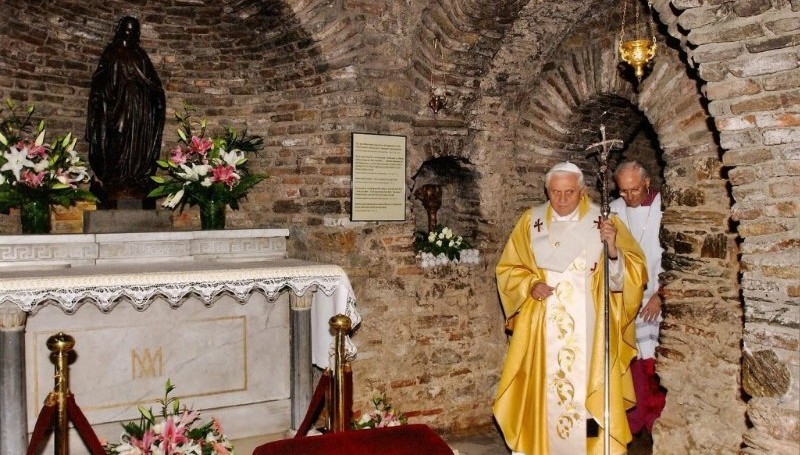Дом Девы Марии
When Jesus was dying on the cross, he exhorted his disciple John to take care of his mother the Virgin Mary. In accordance with his promise, when it became too dangerous for Mary to stay in Palestine, John escorted her to Ephesus where she lived and died in a small house near the summit of mount Coressos about 6 km away from the main city.
After her death the House was abandoned and became ruined and lost to memory until in 1812 a housebound German Catholic nun, Anne Catherine Emmerich had a number of visions about the lives of Jesus and Mary in which she saw Mary’s house in great detail.
Clemens Brentano visited Anne daily for five years and published a book of her visions in Munich in 1852. Julien Guyet, a French priest inspired by the book travelled to Ephesus in 1881 to search for the house. On October 18th on the side of Mount Bulbul, as Coressos was now called, he found ruins which he believed matched the description, but he was unable to raise any interest in his discovery at the time.
However in July 1891 two Lazarist priests Fathers Jung and Poulin from Smyrna (now İzmir) visited Ephesus and on 29 July rediscovered the roofless ruin and a damaged statue of The Virgin. They also discovered that the ruins had for centuries been a place of pilgrimage for the residents of a mountain village thought to have originally been settled by former inhabitants of Ephesus. The most important date for these pilgrims was August 15 which had always been celebrated by Catholics as the day of Mary’s Assumption to Heaven.
After they submitted their report special priests and archaeologists were sent to examine their find and the house was made an official place of pilgrimage by the Catholic Church in 1896, when the first pilgrims were blessed by Pope Leo XIII.
Sister Marie de Mandat-Grancey had been named Foundress of the House in 1891 and she was charged with its restoration and upkeep, work she continued until her death in 1915. The house was restored by 1897 and a shelter for visitors erected. The cross shaped house is very simple, comprising just a bedroom and a kitchen and equipped only with an altar, some candles and pictures of Mary. A red line separates the original ruins from additions made during restoration.
The house is still in the care of Lazarist priests and nuns and a mass is held every day. The spring, which originally flowed under the house is said to have miraculous curative powers and many visitors have discarded walking aids in the vicinity. The house was designated a ‘’Holy Place'’ in 1951 by Pope Pius XII and confirmed with this status in perpetuity by Pope John XXIII. Pope Paul VII visited in July 1967, Pope John Paul II in November 1976 and Pope Benedict XVI on November 29 2006 when he celebrated mass.
The house is sacred not only to Christians but also to Muslims who venerate Mary above all other women as the only perfect woman ever, as well as the mother of the Prophet Jesus. Mary is mentioned more times in the Holy Quran than she is in the New Testament, the only woman to be mentioned by name and one of only eight people to have a chapter of the Quran named in their honour.
On 15 August, Assumption Day, every year there is a joint Orthodox, Catholic and Muslim service at the house, one of the very few places in the world where such a celebration is held.

